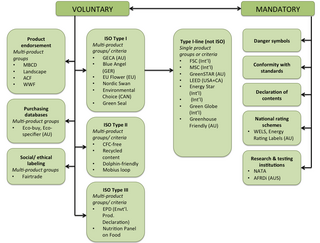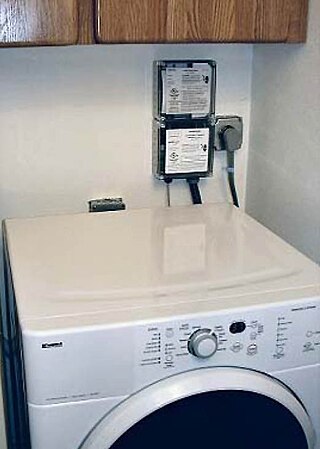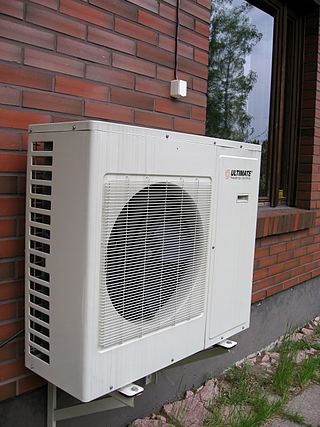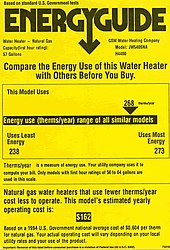
Energy Star is a program run by the U.S. Environmental Protection Agency (EPA) and U.S. Department of Energy (DOE) that promotes energy efficiency. The program provides information on the energy consumption of products and devices using different standardized methods. The Energy Star label is found on more than 75 different certified product categories, homes, commercial buildings, and industrial plants. In the United States, the Energy Star label is also shown on the Energy Guide appliance label of qualifying products.

Energy conservation is the effort to reduce wasteful energy consumption by using fewer energy services. This can be done by using energy more effectively or changing one's behavior to use less service. Energy conservation can be achieved through efficient energy use, which has some advantages, including a reduction in greenhouse gas emissions and a smaller carbon footprint, as well as cost, water, and energy savings.

EU Directive 92/75/EC (1992) established an energy consumption labelling scheme. The directive was implemented by several other directives thus most white goods, light bulb packaging and cars must have an EU Energy Label clearly displayed when offered for sale or rent. The energy efficiency of the appliance is rated in terms of a set of energy efficiency classes from A to G on the label, A being the most energy efficient, G the least efficient. The labels also give other useful information to the customer as they choose between various models. The information should also be given in catalogues and included by internet retailers on their websites.

The Energy Policy Act of 1992, effective October 24, 1992, is a United States government act. It was passed by Congress and set goals, created mandates, and amended utility laws to increase clean energy use and improve overall energy efficiency in the United States. The Act consists of twenty-seven titles detailing various measures designed to lessen the nation's dependence on imported energy, provide incentives for clean and renewable energy, and promote energy conservation in buildings.

Ecolabels and Green Stickers are labeling systems for food and consumer products. The use of ecolabels is voluntary, whereas green stickers are mandated by law; for example, in North America major appliances and automobiles use Energy Star. They are a form of sustainability measurement directed at consumers, intended to make it easy to take environmental concerns into account when shopping. Some labels quantify pollution or energy consumption by way of index scores or units of measurement, while others assert compliance with a set of practices or minimum requirements for sustainability or reduction of harm to the environment. Many ecolabels are focused on minimising the negative ecological impacts of primary production or resource extraction in a given sector or commodity through a set of good practices that are captured in a sustainability standard. Through a verification process, usually referred to as "certification", a farm, forest, fishery, or mine can show that it complies with a standard and earn the right to sell its products as certified through the supply chain, often resulting in a consumer-facing ecolabel.
Energy demand management, also known as demand-side management (DSM) or demand-side response (DSR), is the modification of consumer demand for energy through various methods such as financial incentives and behavioral change through education.

A low-energy house is characterized by an energy-efficient design and technical features which enable it to provide high living standards and comfort with low energy consumption and carbon emissions. Traditional heating and active cooling systems are absent, or their use is secondary. Low-energy buildings may be viewed as examples of sustainable architecture. Low-energy houses often have active and passive solar building design and components, which reduce the house's energy consumption and minimally impact the resident's lifestyle. Throughout the world, companies and non-profit organizations provide guidelines and issue certifications to guarantee the energy performance of buildings and their processes and materials. Certifications include passive house, BBC—Bâtiment Basse Consommation—Effinergie (France), zero-carbon house (UK), and Minergie (Switzerland).

Demand response is a change in the power consumption of an electric utility customer to better match the demand for power with the supply. Until the 21st century decrease in the cost of pumped storage and batteries, electric energy could not be easily stored, so utilities have traditionally matched demand and supply by throttling the production rate of their power plants, taking generating units on or off line, or importing power from other utilities. There are limits to what can be achieved on the supply side, because some generating units can take a long time to come up to full power, some units may be very expensive to operate, and demand can at times be greater than the capacity of all the available power plants put together. Demand response, a type of energy demand management, seeks to adjust in real-time the demand for power instead of adjusting the supply.

Negawatt power is investment to reduce electricity consumption rather than investing to increase supply capacity. In this way, investing in negawatts can be considered as an alternative to a new power station and the costs and environmental concerns can be compared.

The Energy Independence and Security Act of 2007, originally named the Clean Energy Act of 2007, is an Act of Congress concerning the energy policy of the United States. As part of the Democratic Party's 100-Hour Plan during the 110th Congress, it was introduced in the United States House of Representatives by Representative Nick Rahall of West Virginia, along with 198 cosponsors. Even though Rahall was 1 of only 4 Democrats to oppose the final bill, it passed in the House without amendment in January 2007. When the Act was introduced in the Senate in June 2007, it was combined with Senate Bill S. 1419: Renewable Fuels, Consumer Protection, and Energy Efficiency Act of 2007. This amended version passed the Senate on June 21, 2007. After further amendments and negotiation between the House and Senate, a revised bill passed both houses on December 18, 2007 and President Bush, a Republican, signed it into law on December 19, 2007, in response to his "Twenty in Ten" challenge to reduce gasoline consumption by 20% in 10 years.

Efficient energy use, or energy efficiency, is the process of reducing the amount of energy required to provide products and services. There are many technologies and methods available that are more energy efficient than conventional systems. For example, insulating a building allows it to use less heating and cooling energy while still maintaining a comfortable temperature. Another method is to remove energy subsidies that promote high energy consumption and inefficient energy use. Improved energy efficiency in buildings, industrial processes and transportation could reduce the world's energy needs in 2050 by one third.
A minimum energy performance standard (MEPS) is a specification, containing a number of performance requirements for an energy-using device, that effectively limits the maximum amount of energy that may be consumed by a product in performing a specified task.
An energy factor is a metric used in the United States to compare the energy conversion efficiency of residential appliances and equipment. The energy factor is currently used for rating the efficiency of water heaters, dishwashers, clothes washers, and clothes dryers. The term is used by the United States Department of Energy to develop and enforce minimum energy conservation standards under the Energy Conservation Program.

The United States is the second-largest single consumer of energy in the world. The U.S. Department of Energy categorizes national energy use in four broad sectors: transportation, residential, commercial, and industrial. Energy usage in transportation and residential sectors is largely controlled by individual domestic consumers. Commercial and industrial energy expenditures are determined by businesses entities and other facility managers. National energy policy has a significant effect on energy usage across all four sectors.

The Bureau of Energy Efficiency is an agency of the Government of India, under the Ministry of Power, created in March 2002 under the provisions of the nation's 2001 Energy Conservation Act. The agency's function is to encourage the efficient use of energy in India by developing programs to support it. For example, the government proposed to make it mandatory for certain appliances in India to have ratings by the BEE from January 2010 onwards. The mission of the Bureau of Energy Efficiency is to institutionalise energy efficiency services, enable delivery mechanisms in the country and provide leadership to energy efficiency in all sectors of the country. Its primary objective is to reduce energy intensity in the economy.

The National Appliance Energy Conservation Act of 1987 is a United States Act of Congress that regulates energy consumption of specific household appliances. Though minimum Energy Efficiency Standards were first established by the United States Congress in Part B of Title III of the Energy Policy and Conservation Act (EPCA), those standards were then amended by the National Appliance Energy Conservation Act of 1987, the Energy Policy Act of 1992 and the Energy Policy Act of 2005.

In Australia and New Zealand, an energy rating label or energy rating is a label affixed to various appliances prior to retail sale, which allows consumers to compare the energy efficiency of product and allows consumers to know how much power a particular model will use to run. They allow consumers to compare the energy consumption of similar products, and factor lifetime running cost into their purchasing decision. The energy rating label is a mandatory comparison label under Australian regulations for store sales but not for products sold online. The label comprises an energy consumption figure for the appliance and a star rating. The energy consumption figure is an estimate of how much energy the appliance will use over a year, based on assumptions about "average usage".
Energy efficiency gap refers to the improvement potential of energy efficiency or the difference between the cost-minimizing level of energy efficiency and the level of energy efficiency actually realized. It has attracted considerable attention among energy policy analysts, because its existence suggests that society has forgone cost-effective investments in energy efficiency, even though they could significantly reduce energy consumption at low cost. This term was first "coined" by Eric Hirst and Marilyn Brown in a paper entitled "Closing the Efficiency Gap: Barriers to the Efficient Use of Energy" in 1990.

CLASP is an international nonprofit organization which provides technical and policy support to governments worldwide and works to implement energy efficiency standards and labels (S&L) for appliances, lighting, and equipment. It specializes in publishing studies and analyses with relevance to S&L practitioners.
The Energy Conservation Program for Consumer Products Other Than Automobiles is a regulatory program that enforces minimum energy conservation standards for appliances and equipment in the United States. The program was established under Part B of Title III of the Energy Policy and Conservation Act of 1975 and gives the Department of Energy (DOE) the authority to develop and implement test procedures and minimum standards for more than 60 products covering residential, commercial and industrial, lighting, and plumbing applications. The Department of Energy is required to set standards that are "technologically feasible and economically justified."













